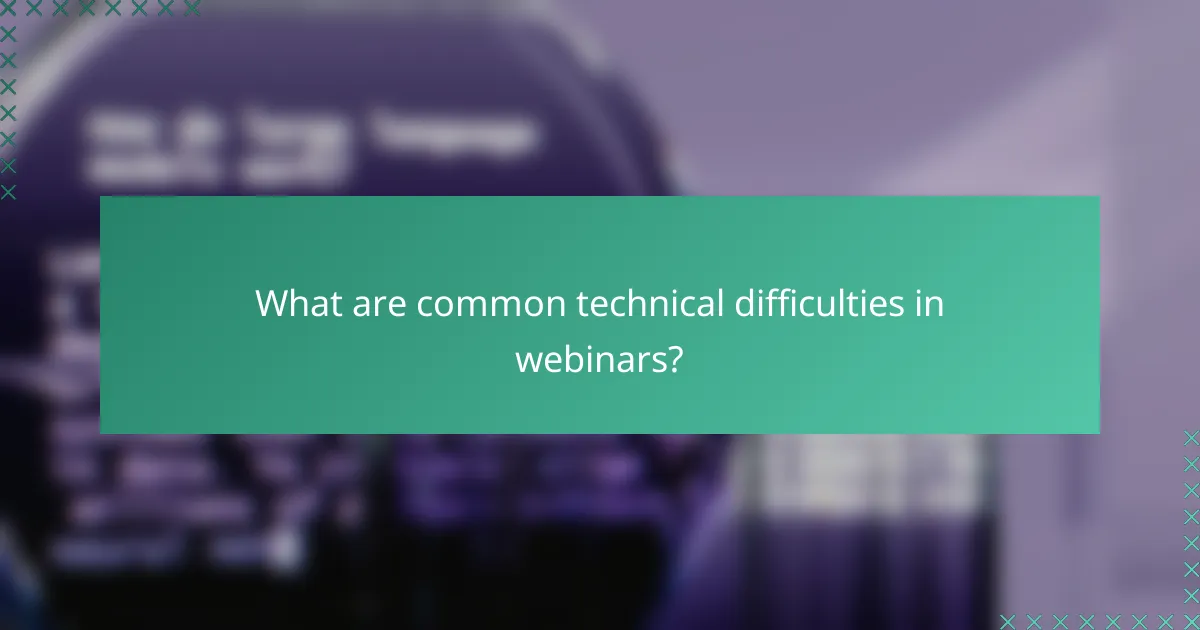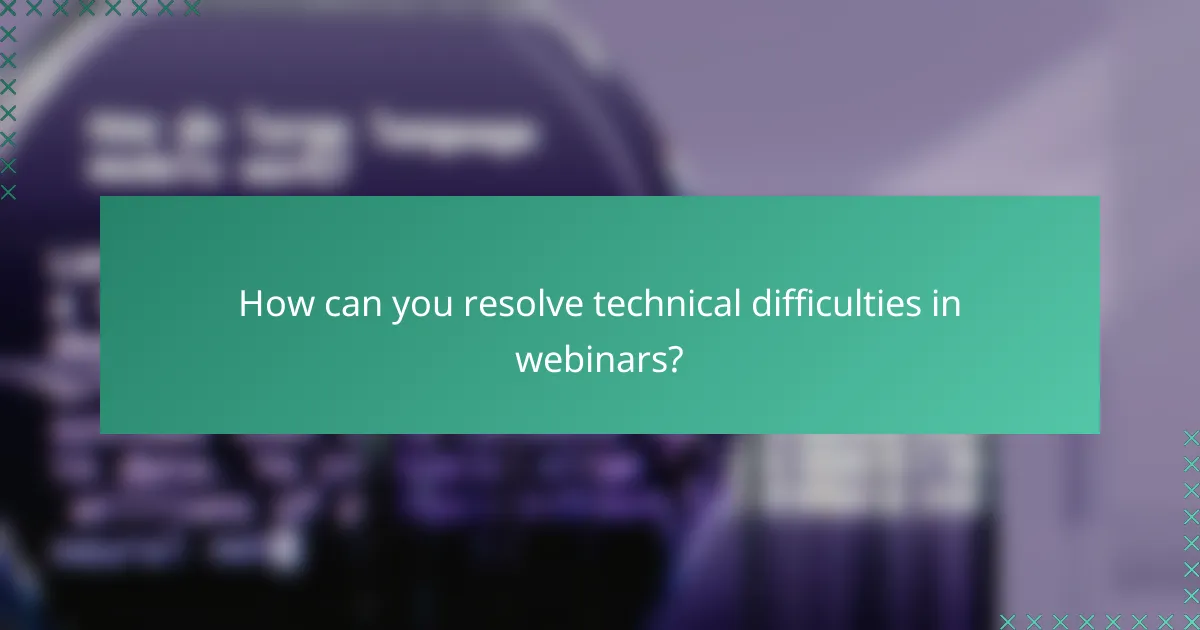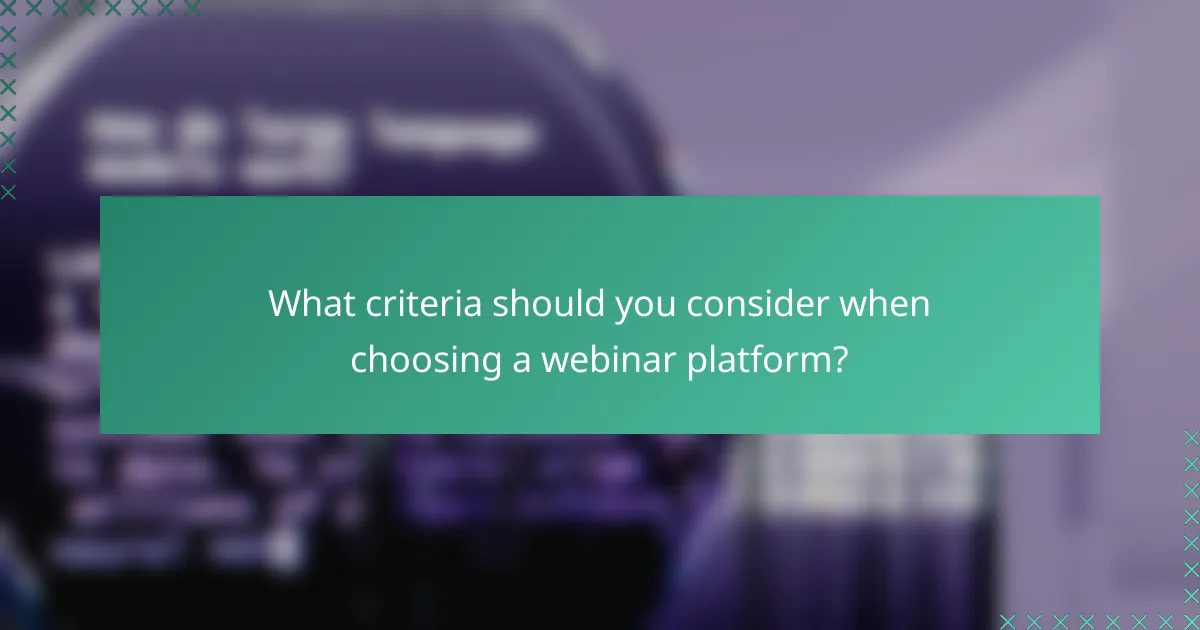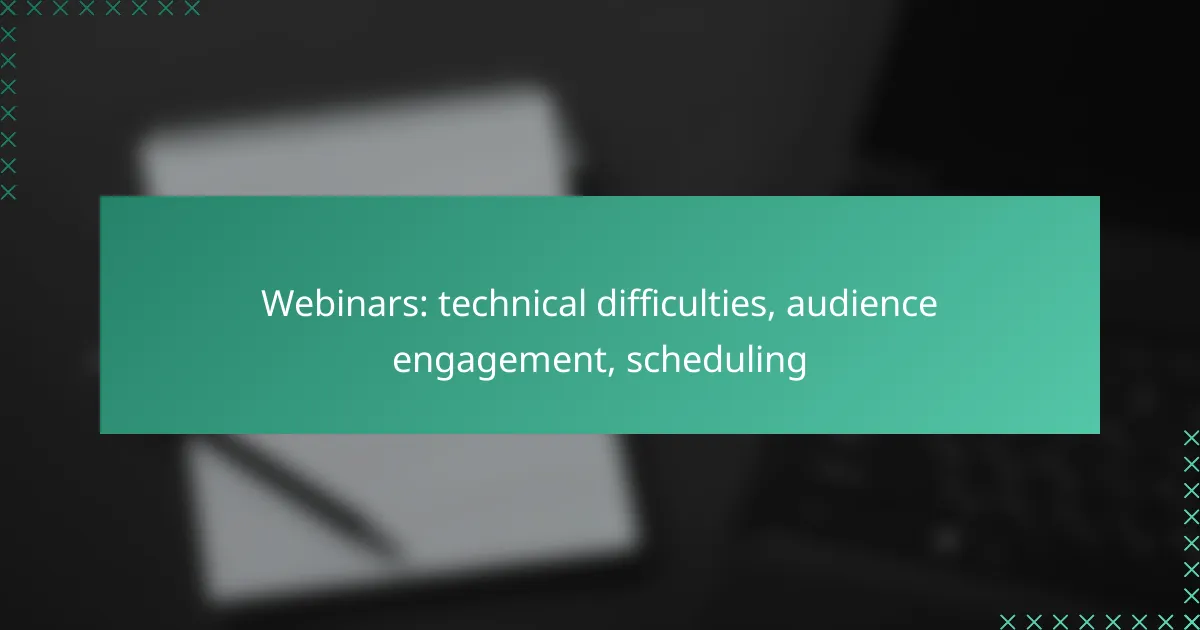Webinars can be a powerful tool for communication, but they often come with technical difficulties such as audio issues and connection problems that can hinder engagement. To ensure a smooth experience, it’s vital to test equipment and use reliable software while also incorporating interactive elements like polls and Q&A sessions to keep the audience engaged. By addressing these challenges proactively, presenters can create a more effective and enjoyable webinar experience.

What are common technical difficulties in webinars?
Common technical difficulties in webinars include audio issues, video lag, connection problems, platform compatibility, and screen sharing errors. These challenges can disrupt the flow of the presentation and negatively impact audience engagement, making it essential to address them proactively.
Audio issues
Audio issues are among the most frequent problems encountered during webinars. Participants may experience muffled sound, echoes, or complete audio dropouts, which can hinder communication. To mitigate these issues, ensure that all speakers use high-quality microphones and conduct a sound check before the event.
Consider using headsets instead of built-in computer microphones to reduce background noise. Additionally, remind participants to mute their microphones when not speaking to minimize interference.
Video lag
Video lag occurs when there is a delay between the speaker’s actions and what the audience sees. This can lead to confusion and disengagement. To reduce video lag, use a stable internet connection and lower the video resolution if necessary.
Encourage participants to close unnecessary applications that may consume bandwidth. A wired connection is often more reliable than Wi-Fi, which can help maintain smoother video playback.
Connection problems
Connection problems can disrupt the entire webinar experience, causing participants to drop out or struggle to join. These issues often stem from poor internet connectivity or server overload. To address this, ensure that both the host and participants have a reliable internet connection, ideally with speeds of at least 5 Mbps for optimal performance.
Consider providing a dial-in option for participants who may face connectivity issues. This allows them to join the webinar via phone, ensuring they can still participate even if their internet connection fails.
Platform compatibility
Platform compatibility issues arise when the webinar software does not function well with certain operating systems or browsers. This can lead to difficulties in accessing the webinar or using features like chat and polls. To avoid these problems, choose a widely supported platform and provide clear instructions on system requirements.
Encourage participants to test their setup ahead of time and offer technical support during the registration process to address any compatibility concerns.
Screen sharing errors
Screen sharing errors can occur when the host is unable to display their content properly, leading to frustration for both the presenter and the audience. Common issues include incorrect screen selection or software permissions not being granted. To prevent these errors, practice the screen sharing process before the webinar.
Ensure that all necessary permissions are enabled on the host’s device and consider using a second monitor for smoother transitions. Providing a backup plan, such as sharing files via email, can also help maintain engagement if technical difficulties arise.

How can you resolve technical difficulties in webinars?
To resolve technical difficulties in webinars, proactive measures are essential. This includes testing equipment, using reliable software, and providing clear troubleshooting guides to ensure a smooth experience for both presenters and attendees.
Test equipment beforehand
Testing your equipment before the webinar is crucial to avoid last-minute issues. Check your microphone, camera, and internet connection at least a day in advance. This allows time to address any problems that may arise.
Consider running a practice session with a colleague to simulate the actual event. This can help identify any potential technical glitches and ensure that all participants are familiar with the platform.
Use reliable software
Selecting dependable webinar software is vital for a seamless experience. Look for platforms that have a strong reputation for stability and user-friendliness, such as Zoom, Microsoft Teams, or Webex. These tools often provide features like screen sharing, chat, and recording options that enhance engagement.
Before the event, familiarize yourself with the software’s functionalities. This includes knowing how to manage participants, share content, and troubleshoot common issues that may arise during the session.
Provide troubleshooting guides
Offering troubleshooting guides can empower attendees to resolve minor issues independently. Create a simple document or webpage that outlines common problems and their solutions, such as audio issues or connection drops.
Distribute this guide before the webinar and remind participants to refer to it if they encounter difficulties. This not only reduces frustration but also allows the host to focus on delivering content rather than managing technical issues.

How to engage your audience during webinars?
Engaging your audience during webinars is crucial for maintaining interest and ensuring effective communication. Techniques such as interactive polls, Q&A sessions, chat features, and gamification can significantly enhance participation and interaction.
Interactive polls
Interactive polls allow participants to express their opinions or knowledge on specific topics in real-time. This not only keeps the audience involved but also provides instant feedback to the presenter. Consider using tools that enable quick responses, ensuring that polls are simple and relevant to the content.
For best results, launch polls at strategic points during the webinar, such as after introducing a new concept or before transitioning to a new topic. Aim for a balance between engaging questions and informative content to maintain focus.
Q&A sessions
Q&A sessions provide an opportunity for the audience to ask questions and clarify doubts. This interaction fosters a sense of community and encourages deeper understanding of the material presented. Allocate specific time slots for Q&A to ensure it fits seamlessly into the webinar flow.
Encourage participants to submit questions throughout the session, either through a dedicated chat feature or by raising their hands. This can help you gauge audience interest and tailor your responses accordingly.
Chat features
Utilizing chat features allows participants to communicate with each other and the presenter in real-time. This can enhance engagement by enabling discussions, sharing resources, and asking questions without interrupting the flow of the presentation. Ensure that the chat is monitored to facilitate meaningful interactions.
Consider setting guidelines for chat use to keep conversations relevant and respectful. Highlighting key comments or questions from the chat during the presentation can also reinforce audience involvement.
Gamification elements
Incorporating gamification elements, such as quizzes or challenges, can make webinars more enjoyable and engaging. These elements can motivate participants to pay closer attention and actively participate. Simple quizzes related to the content can reinforce learning and provide a fun break from traditional presentations.
When implementing gamification, ensure that the activities are easy to understand and accessible to all participants. Offering small rewards or recognition for participation can further enhance motivation and engagement.

What are effective scheduling strategies for webinars?
Effective scheduling strategies for webinars involve selecting the right time, day, and frequency to maximize attendance and engagement. By considering factors such as time zones, optimal days and times, and the potential for recurring sessions, you can significantly enhance the success of your webinars.
Time zone considerations
When scheduling webinars, it’s crucial to account for the time zones of your target audience. If your participants are spread across different regions, aim for a time that accommodates the majority. Tools like world clocks or scheduling apps can help identify overlapping hours that work for most attendees.
For instance, if your audience is primarily in Europe and North America, scheduling around 3 PM CET may capture both regions effectively. Avoid times that fall too early or too late for significant portions of your audience.
Optimal days and times
Research indicates that midweek days, particularly Tuesday through Thursday, tend to yield higher attendance rates for webinars. Mondays often see people catching up on work, while Fridays are typically reserved for winding down before the weekend.
In terms of timing, late mornings or early afternoons are generally preferred. Aiming for slots around 11 AM to 1 PM local time can help ensure that participants are alert and engaged.
Recurring sessions
Implementing recurring sessions can build a loyal audience and streamline your scheduling process. Consider hosting weekly or monthly webinars on a consistent day and time, which allows attendees to plan ahead and increases the likelihood of repeat participation.
When planning recurring webinars, be mindful of varying the content or format to keep the audience engaged. For example, alternating between expert panels and Q&A sessions can maintain interest and encourage ongoing attendance.

What criteria should you consider when choosing a webinar platform?
When selecting a webinar platform, consider factors such as ease of use, audience capacity, engagement features, and integration capabilities. These criteria will help ensure a smooth experience for both hosts and participants.
Technical difficulties
Technical difficulties can significantly impact the success of a webinar. Look for platforms that offer reliable performance, minimal latency, and robust support for various devices and browsers. Testing the platform before the event is crucial to identify and resolve potential issues.
Common technical challenges include poor audio or video quality, connection drops, and software glitches. Choose a platform that provides troubleshooting resources and customer support to address these problems quickly.
Audience engagement
Engaging your audience is vital for a successful webinar. Select a platform that offers interactive features such as polls, Q&A sessions, and chat functionalities. These tools can help maintain participant interest and encourage interaction throughout the presentation.
Consider using features like breakout rooms for smaller discussions or gamification elements to boost engagement. Analyzing audience feedback post-webinar can also provide insights for future improvements.
Scheduling
Scheduling is an essential aspect of webinar planning. Choose a platform that allows for easy scheduling and calendar integration, making it simple for participants to join. Look for options that accommodate different time zones, especially if your audience is global.
Sending reminders and follow-up emails can enhance attendance rates. Utilize automated scheduling tools to streamline the process and reduce the chances of conflicts or missed sessions.
